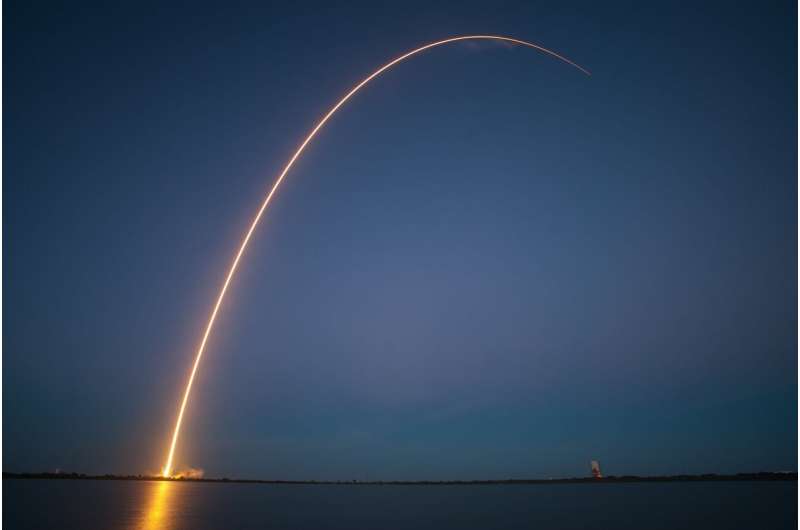Winchcombe meteorite's tumultuous space odyssey uncovered by nano-analysis
Thursday, 18 April 2024 12:11 Detailed nano-analysis has revealed the Winchcombe meteorite underwent significant transformations involving water interaction and repeated fragmentations during its journey through space, finally resting in an English pasture in 2021.
The collaborative research effort included scientists from the UK, Europe, Australia, and the USA, employing a suite of advanced analytical methods typicall
Detailed nano-analysis has revealed the Winchcombe meteorite underwent significant transformations involving water interaction and repeated fragmentations during its journey through space, finally resting in an English pasture in 2021.
The collaborative research effort included scientists from the UK, Europe, Australia, and the USA, employing a suite of advanced analytical methods typicall Why Figuring Out How Potassium Is Destroyed in Stars Is Important to Understanding the Universe
Thursday, 18 April 2024 12:11 If you want to know where elements come from, look to the stars. Almost every element heavier than helium is formed through nuclear reactions in stars. But which stellar processes are responsible for these elements? Can we find patterns in how much of each element we observe in different astrophysical environments, like stars, galaxies or globular clusters?
Recently, our team of NC State r
If you want to know where elements come from, look to the stars. Almost every element heavier than helium is formed through nuclear reactions in stars. But which stellar processes are responsible for these elements? Can we find patterns in how much of each element we observe in different astrophysical environments, like stars, galaxies or globular clusters?
Recently, our team of NC State r ICEYE secures substantial growth investment to bolster its SAR satellite fleet
Thursday, 18 April 2024 12:11 ICEYE, a leader in synthetic aperture radar (SAR) technology for Earth Observation, has successfully closed an oversubscribed $93M funding round aimed at expanding its SAR satellite operations. This recent financial boost will support the enhancement of the largest SAR satellite constellation globally and the development of new data and subscription services. This round is a continuation of the
ICEYE, a leader in synthetic aperture radar (SAR) technology for Earth Observation, has successfully closed an oversubscribed $93M funding round aimed at expanding its SAR satellite operations. This recent financial boost will support the enhancement of the largest SAR satellite constellation globally and the development of new data and subscription services. This round is a continuation of the China launches space collaboration forum with Latin America and the Caribbean
Thursday, 18 April 2024 12:11 Next week, Wuhan, Hubei province, will be the site of the first-ever China-Latin America and the Caribbean Space Cooperation Forum, as announced by the China National Space Administration (CNSA).
This inaugural two-day event, a collaborative effort among the CNSA, the Foreign Ministry, and the government of Hubei province, is scheduled to begin on April 24, which is celebrated as China's S
Next week, Wuhan, Hubei province, will be the site of the first-ever China-Latin America and the Caribbean Space Cooperation Forum, as announced by the China National Space Administration (CNSA).
This inaugural two-day event, a collaborative effort among the CNSA, the Foreign Ministry, and the government of Hubei province, is scheduled to begin on April 24, which is celebrated as China's S GDFAU joins NASA for university nanosatellite project
Thursday, 18 April 2024 12:11 Florida Atlantic University's College of Engineering and Computer Science has been chosen as one of eight U.S. university teams to collaborate with NASA and the U.S. military. This partnership aims to boost innovation and expertise in the small satellite sector through the 2024 Mission Concept Program.
The program, a part of NASA's CubeSat Launch Initiative (CSLI), involves cooperation wit
Florida Atlantic University's College of Engineering and Computer Science has been chosen as one of eight U.S. university teams to collaborate with NASA and the U.S. military. This partnership aims to boost innovation and expertise in the small satellite sector through the 2024 Mission Concept Program.
The program, a part of NASA's CubeSat Launch Initiative (CSLI), involves cooperation wit How to Tell Space Rocks from Space Junk
Thursday, 18 April 2024 12:11 Upcoming surveys will find dozens of near-Earth objects each night, but some of those objects will be space junk rather than asteroids. How will we tell the difference?
b>Masquerading as Asteroids br> /b>
When humankind sent its first rocket toward the Moon 65 years ago, it marked the beginning of a long era of lunar exploration. Now, the cast-off rocket parts from decades of lunar missi
Upcoming surveys will find dozens of near-Earth objects each night, but some of those objects will be space junk rather than asteroids. How will we tell the difference?
b>Masquerading as Asteroids br> /b>
When humankind sent its first rocket toward the Moon 65 years ago, it marked the beginning of a long era of lunar exploration. Now, the cast-off rocket parts from decades of lunar missi China gears up for Shenzhou XVIII manned space mission
Thursday, 18 April 2024 12:11 The China Manned Space Agency has announced that the Shenzhou XVIII mission is poised for launch in the upcoming days, aiming to deliver three astronauts to the Tiangong space station.
On Wednesday, the Shenzhou XVIII crew spacecraft, along with its Long March 2F rocket, was transferred to the service tower at the Jiuquan Satellite Launch Center located in the Gobi Desert of northwestern C
The China Manned Space Agency has announced that the Shenzhou XVIII mission is poised for launch in the upcoming days, aiming to deliver three astronauts to the Tiangong space station.
On Wednesday, the Shenzhou XVIII crew spacecraft, along with its Long March 2F rocket, was transferred to the service tower at the Jiuquan Satellite Launch Center located in the Gobi Desert of northwestern C Dubai floods seen from space
Thursday, 18 April 2024 11:45 Image:
Dubai floods seen from space
Image:
Dubai floods seen from space SpaceX tallies 1st of two launches over two days from Space Coast
Thursday, 18 April 2024 11:29
SpaceX launched Wednesday evening the first of a pair of Space Coast rockets in two days, both carrying batches of the company's Starlink satellites.
A Falcon 9 rocket carrying 23 of the internet satellites for SpaceX's growing constellation lifted off at 5:26 p.m. Eastern time from Kennedy Space Center's Launch Pad 39-A amid clear blue skies.
This is the 12th flight of the first-stage booster that will aim for a recovery landing downrange in the Atlantic on the droneship Just Read the Instructions.
This was the 28th launch from the Space Coast in 2024, with launch No. 29 targeting Thursday evening from neighboring Cape Canaveral Space Force Station.
Another Falcon 9 carrying more Starlink satellites is aiming for liftoff during four-hour window from 6:40 p.m. to 10:40 p.m. at Canaveral's Space Launch Complex 40 with a backup window Friday from 6:14 p.m. to 10:14 p.m.
Space Launch Delta 45's weather squadron forecasts a 90% chance for good conditions for that launch.
These will be the 157th and 158th overall Starlink launches since the first operational deployment of the internet satellites in 2019.
Earth Observation Excellence Award 2024 winner
Thursday, 18 April 2024 11:04
Celebrating the outstanding efforts of scientists and researchers who have advanced the innovative application of Earth observation data, ESA proudly announces the recipient of this year's esteemed Excellence Award. Dr Iestyn Woolway, from Bangor University in the UK, wins the 2024 Earth Observation Excellence Award.
Nelson defends “very tough choices” in NASA’s budget proposal
Thursday, 18 April 2024 10:44

NASA chief warns of Chinese military presence in space
Thursday, 18 April 2024 07:28
China is bolstering its space capabilities and is using its civilian program to mask its military objectives, the head of the US space agency NASA said Wednesday, warning that Washington must remain vigilant.
"China has made extraordinary strides especially in the last 10 years, but they are very, very secretive," NASA administrator Bill Nelson told lawmakers on Capitol Hill.
"We believe that a lot of their so-called civilian space program is a military program. And I think, in effect, we are in a race," Nelson added.
He said he hoped Beijing would "come to its senses and understand that civilian space is for peaceful uses," but added, "We have not seen that demonstrated by China."
Nelson's comment came as he testified before the House appropriations committee on NASA's budget for fiscal 2025.
He said the United States should land on the moon again before China does, as both nations pursue lunar missions, but he expressed concern that were Beijing to arrive first, it could say, "'Okay, this is our territory, you stay out.'"
The United States is planning to put astronauts back on the moon in 2026 with its Artemis 3 mission.
Φsat-2 gets two new AI apps
Thursday, 18 April 2024 06:10
Φsat-2, ESA’s groundbreaking cubesat scheduled for launch in June, will now include two new AI-driven apps destined to demonstrate a crucial role in future environmental monitoring from space. The apps, which focus on marine pollution and wildfires, were the winning entries in ESA’s OrbitalAI Challenge.
From Self-Employed to Self-Made: The POD Entrepreneur's Journey
Thursday, 18 April 2024 02:23 POD (Print on Demand) businesses have taken the entrepreneurial world by storm. With minimal investment and unlimited potential, many self-employed individuals have found success as self-made POD entrepreneurs. This article will delve into the journey of these individuals, highlighting their challenges, strategies for growth, and tips for those looking to embark on the same path.
b>1. Dis
POD (Print on Demand) businesses have taken the entrepreneurial world by storm. With minimal investment and unlimited potential, many self-employed individuals have found success as self-made POD entrepreneurs. This article will delve into the journey of these individuals, highlighting their challenges, strategies for growth, and tips for those looking to embark on the same path.
b>1. Dis Astrobotic eyes military customers for reusable Xogdor suborbital rocket
Wednesday, 17 April 2024 20:53


